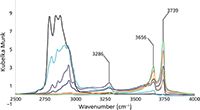Monitoring the Thermal Treatment of a Heterogeneous Catalyst Using DRIFTS
Application Notebook
The thermal treatment of a grafted Sn-SiO2 catalyst was monitored in situ using diffuse reflectance infrared Fourier transform spectroscopy (DRIFTS).
The thermal treatment of a grafted Sn-SiO2catalyst was monitored in situ using diffuse reflectance infrared Fourier transform spectroscopy (DRIFTS). Structural changes and organic intermediates could be observed.
Thermal treatment is an important but oftentimes poorly understood step during the synthesis of heterogeneous catalysts. In situ spectroscopic techniques can provide valuable insights into structural changes of such materials upon heating.
DRIFTS is an ideal technique for such an application because powder samples can be used without further preparation, high temperatures and pressures can be applied, and gases can be flown over the catalysts easily.
Experimental Conditions
The FT-IR spectra were recorded by averaging 32 scans with a resolution of 8 cm-1. Using the heated environmental chamber inserted into the DiffusIR diffuse reflection sampling accessory (PIKE Technologies), the environmental chamber was flushed with synthetic air at a flow rate of ca. 20 mL/min and heated at a rate of 20 °C/min up to a temperature of 550 °C. Prior to the thermal treatment, the Sn(NMe2)4 was deposited on dehydrated SiO2 using a grafting technique under static vacuum.
Results
By applying the environmental chamber and heating the sample up to 550 °C, conditions comparable to the ones in conventional calcination ovens could be achieved. Figure 1 shows spectra recorded at different temperatures.

Figure 1: Spectra recorded at 25 °C (black), 100 °C (light blue), 200 °C (purple), 300 °C (dark blue), 400 °C (red), 500 °C (green), and 550 °C (yellow).
At room temperature intense bands between 2750 and 3000 cm-1 can be observed which can be assigned to C-H stretch vibrations of the organic Sn precursor. Already at 100 °C these bands significantly decreased, while bands at 3286 cm-1 and 3656 cm-1 appear.
The band at 3286 cm-1 has been assigned to N-H stretch vibrations of ammonium species that could be formed as intermediates on the silica surface upon heating. The other band at 3656 cm-1 originates from Sn-OH groups that have been formed due to restructuring of the Sn surface species during the calcination (1).
At 200 °C another band at 3739 cm-1 is clearly visible. This band stems from the Si-OH stretch band of isolated silanols (2). The intensity of this band increases upon further heating, indicating the opening of siloxane bridges on the silica surface.
At 400 °C the intensities of the C-H stretch vibrations have further decreased and the vibration at 3286 cm-1 completely disappeared while the Si-OH and Sn-OH stretch bands were still increasing in intensity. At the final temperature of 550 °C, all organic groups have been burned off and the desired and catalytically active Sn sites are present.
Conclusions
The DiffusIR accessory is a valuable tool to understand structural changes in heterogeneous catalysts during thermal treatment. The sequence of formation of intermediates, Sn-OH and Si-OH, species could be observed. The gained insights can potentially be used to improve the synthesis of catalysts.
References
(1) P. Larkin, Infrared and Raman Spectroscopy; Principles and Spectral Interpretation (Elsevier Inc., San Diego, California, 2011).
(2) F. Rascón, R. Wischert, and C. Copéret, Chem. Sci. 2, 1449–1456 (2011).
PIKE Technologies, Inc.
6125 Cottonwood Drive, Madison, WI 53719
tel. (608) 274-2721
Website: www.piketech.com

A Seamless Trace Elemental Analysis Prescription for Quality Pharmaceuticals
March 31st 2025Quality assurance and quality control (QA/QC) are essential in pharmaceutical manufacturing to ensure compliance with standards like United States Pharmacopoeia <232> and ICH Q3D, as well as FDA regulations. Reliable and user-friendly testing solutions help QA/QC labs deliver precise trace elemental analyses while meeting throughput demands and data security requirements.